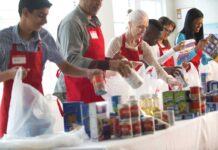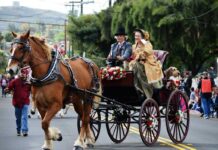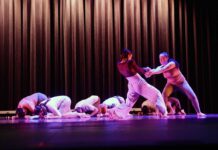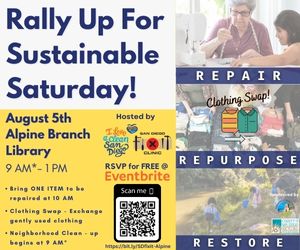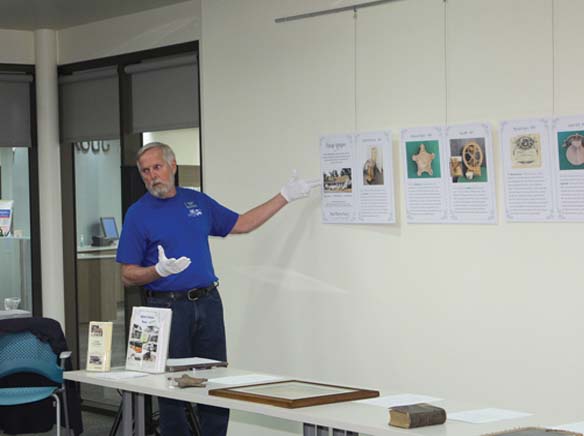
Alpine Historical Society President Tom Myers donned white gloves before delicately picking up a six-inch wide metal star cast sometime around the American civil war.
“We don’t know who this was given to so we can’t repatriate it to the correct gravesite,” Myers said.
He went on to tell the five attendees at the Alpine library event the story behind roughly 10 antiques, each over 100 years old ,all laid out on tables for attendees to see up-close.
The March 5 event was held in conjunction with the unveiling of a new poster exhibit at the library featuring information on antiques that belonged to the earliest settlers of Alpine.
“When I go to a museum, I want to hear the story, the background, the history and so forth,” Myers said.
He explained that the chosen items were plucked from the society’s extensive collection because they are conducive to storytelling.
“They have an interesting story line that connects through them: they not only have a story of their own but they also connect to a historic Alpine family and give the flavor of what it was like to live here 125 years ago,” Myers said.
After putting the antique star gently on the library table, Myers delicately held up the marriage certificate of Edward Foss and Carrie Athearn, preserved and framed for posterity.
According to Myers, Foss was wounded at the civil war battle of Gaines’ Mill when he took a bullet to his femur that was never entirely extricated for fear of infection, a common practice in battlefield medicine of the day.
Embedding the little lesson on civil-war era medical care into his tale, Myers revealed that Foss was held captive at Libby prison in Virginia and later hospitalized in New York. With that, Myers wove popular music during Reconstruction into his interactive lecture in noting that Foss returned to his pre-war profession of building pipe organs.
To emphasize the importance of education among early Alpine residents, Myers held up a schoolchild’s slate that once belonged to the Foss family, and explained that after Foss married Carrie Athearn, he moved to Alpine to pursue a career in beekeeping inspired by John Harbison’s tales of success. In 1877, he built a small lean-to style schoolhouse connected to his home that served as the second school in Alpine, successor to the first one built by the Webb family in 1975.
Myers said that Foss passed away in 1898 while shelling peas under an old oak tree. Alpine Historical Society Past President Carol Morrison called out from the library audience that the society has an idea of which oak tree it might be but cannot confirm that fact and with a giggle said that even with the ability to determine where Foss is buried, she’s not sure if they want to dig him up.
The historian then drew the audience’s attention to an antique McGuffy’ Reader, used to teach young children how to read.
“It’s fascinating to look through a McGuffy’s reader,” said Myers.
He read a few phrases of rhyming patterns then asked the audience if they’d want to learn like that— audibly and with repetitive phrases— to ensuing chuckles.
Talking over a wooden butter churn with a hand crank, Myers said that such an item would have been a luxury item, then shared a bit of behind-the-scenes society work involved with cataloguing items and explained that volunteers utilize Past Perfect software to keep track of the collection.
“It’s really interesting how we acquire things. Sometimes, people just call on the phone and if it sounds like something we’d want to add to the collection then we go on over and see what they’ve got,” Myers said.
He then took hold of a washboard and attempted to convey the extent of how much work one load of laundry would take to complete.
“Before they had wringer washers, they’d have to haul water up from a well and hand wash everything then wring it out and hang it on the line. Imagine what that was like: unpaved streets, maybe dirt floors in a house— picture how dirty everything got and how much work someone would put in just to do laundry.”
Closing out the evening, Myers invited the audience to come check out the items on display as well as the accompanying educational posters, then encouraged everyone to pay a visit to the Alpine Historical Society museum housed at the Nichols’ house on Tavern road with the promise that volunteers would be happy to answer questions there as well.
“We have the best docents in Alpine and we all enjoy what we do,” Myers said.


